 |
| January 10, 2023 | Volume 19 Issue 01 |
Software News & Products
Designfax weekly eMagazine
Archives
Partners
Manufacturing Center
Product Spotlight
Modern Applications News
Metalworking Ideas For
Today's Job Shops
Tooling and Production
Strategies for large
metalworking plants
hyperMILL 2024 CAD/CAM software suite
 OPEN MIND Technologies has introduced its latest hyperMILL 2024 CAD/CAM software suite, which includes a range of powerful enhancements to its core toolpath capabilities, as well as new functionality for increased NC programming efficiency in applications ranging from 2.5D machining to 5-axis milling. New and enhanced capabilities include: Optimized Deep Hole Drilling, a new algorithm for 3- and 5-axis Rest Machining, an enhanced path layout for the 3D Plane Machining cycle, better error detection, and much more.
OPEN MIND Technologies has introduced its latest hyperMILL 2024 CAD/CAM software suite, which includes a range of powerful enhancements to its core toolpath capabilities, as well as new functionality for increased NC programming efficiency in applications ranging from 2.5D machining to 5-axis milling. New and enhanced capabilities include: Optimized Deep Hole Drilling, a new algorithm for 3- and 5-axis Rest Machining, an enhanced path layout for the 3D Plane Machining cycle, better error detection, and much more.
Learn more.
Find test data issues faster: AI Anomaly Detector
 It can take months of manual engineering time to detect test data abnormalities. Now the task can be performed in a flash. Artificial intelligence software provider Monolith has developed the industry's first AI-powered Anomaly Detector software that can discover a broad range of issues in test data fast -- measurement or sensor errors, user errors, system malfunctions, or incorrect usage of the system during testing. It does this by automating the process of raw test data inspection to look for potential errors or abnormalities across hundreds of test channels.
It can take months of manual engineering time to detect test data abnormalities. Now the task can be performed in a flash. Artificial intelligence software provider Monolith has developed the industry's first AI-powered Anomaly Detector software that can discover a broad range of issues in test data fast -- measurement or sensor errors, user errors, system malfunctions, or incorrect usage of the system during testing. It does this by automating the process of raw test data inspection to look for potential errors or abnormalities across hundreds of test channels.
Learn more.
Loss-free conversion of 3D/CAD data
 CT CoreTech-nologie has further developed its state-of-the-art CAD converter 3D_Evolution and is now introducing native interfaces for reading Solidedge and writing Nx and Solidworks files. It supports a wide range of formats such as Catia, Nx, Creo, Solidworks, Solidedge, Inventor, Step, and Jt, facilitating smooth interoperability between different systems and collaboration for engineers and designers in development environments with different CAD systems.
CT CoreTech-nologie has further developed its state-of-the-art CAD converter 3D_Evolution and is now introducing native interfaces for reading Solidedge and writing Nx and Solidworks files. It supports a wide range of formats such as Catia, Nx, Creo, Solidworks, Solidedge, Inventor, Step, and Jt, facilitating smooth interoperability between different systems and collaboration for engineers and designers in development environments with different CAD systems.
Learn more.
Top 5 reasons for solder joint failure
 Solder joint reliability is often a pain point in the design of an electronic system. According to Tyler Ferris at ANSYS, a wide variety of factors affect joint reliability, and any one of them can drastically reduce joint lifetime. Properly identifying and mitigating potential causes during the design and manufacturing process can prevent costly and difficult-to-solve problems later in a product lifecycle.
Solder joint reliability is often a pain point in the design of an electronic system. According to Tyler Ferris at ANSYS, a wide variety of factors affect joint reliability, and any one of them can drastically reduce joint lifetime. Properly identifying and mitigating potential causes during the design and manufacturing process can prevent costly and difficult-to-solve problems later in a product lifecycle.
Read this informative ANSYS blog.
How a BattleBot was built using Onshape
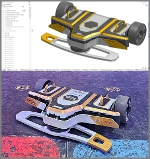 Learn how RoboGym Robotics, a veteran BattleBots team, said goodbye to Solidworks and took their design game to the next level using Onshape, the cloud-native, all-in-one CAD and PDM solution. RoboGym was able to analyze key components of their Roundhouse BattleBot like its armor and weapon bar, run simulations, collaborate, iterate, and optimize their design to its fullest.
Learn how RoboGym Robotics, a veteran BattleBots team, said goodbye to Solidworks and took their design game to the next level using Onshape, the cloud-native, all-in-one CAD and PDM solution. RoboGym was able to analyze key components of their Roundhouse BattleBot like its armor and weapon bar, run simulations, collaborate, iterate, and optimize their design to its fullest.
Read this informative Onshape blog.
Trick to measuring angles in SOLIDWORKS
 Learn from the pros at TriMech how to take angle measurements easily in SOLID-WORKS. TriMech has an entire YouTube channel dedicated to SOLIDWORKS tips, and the company is excellent at training too.
Learn from the pros at TriMech how to take angle measurements easily in SOLID-WORKS. TriMech has an entire YouTube channel dedicated to SOLIDWORKS tips, and the company is excellent at training too.
View the video.
COMSOL Multiphysics Version 6.2 is here
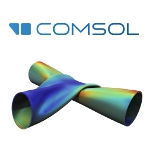 COMSOL Multiphysics Version 6.2 introduces faster solvers for turbulent fluid flow, electric motors, and room acoustics. It also brings data-driven surrogate model functionality for creating multiphysics-based digital twins and building fast and accurate standalone simulation apps. Get the full details of what's new in the latest version.
COMSOL Multiphysics Version 6.2 introduces faster solvers for turbulent fluid flow, electric motors, and room acoustics. It also brings data-driven surrogate model functionality for creating multiphysics-based digital twins and building fast and accurate standalone simulation apps. Get the full details of what's new in the latest version.
Learn more.
17 ways SOLIDWORKS 2024 helps you work faster
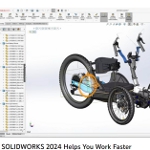 SOLIDWORKS 2024 helps designers and engineers work faster than ever. Learn all about improvements to core 3D CAD modeling features, new 3D modeling techniques, and graphical and software performance boosts that will help you get your parts made and your products developed in record time.
SOLIDWORKS 2024 helps designers and engineers work faster than ever. Learn all about improvements to core 3D CAD modeling features, new 3D modeling techniques, and graphical and software performance boosts that will help you get your parts made and your products developed in record time.
View the video.
6 tips to streamline workflow in Mastercam 2024
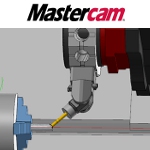 Mastercam 2024 CAD/CAM software has been intentionally upgraded to make programming fast and easy. It prioritizes streamlining workflow so that the entire machining process -- from design to QC -- is as efficient as possible. Learn how to maximize the benefits of Mastercam 2024, including special toolpaths, easier hole-making operations, wireframe shortcuts, and more.
Mastercam 2024 CAD/CAM software has been intentionally upgraded to make programming fast and easy. It prioritizes streamlining workflow so that the entire machining process -- from design to QC -- is as efficient as possible. Learn how to maximize the benefits of Mastercam 2024, including special toolpaths, easier hole-making operations, wireframe shortcuts, and more.
Read this informative Mastercam blog.
How CT data analysis is helping TE Connectivity reach their goal of end-to-end quality inspection
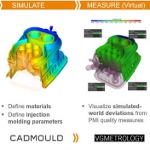 In a bid to cut their mold and part development process to 25% of the time it took in the past, TE Connectivity has taken ambitious steps to interconnect design and simulation with quality measurement. Learn how the company, in collaboration with PTC (Creo) and Volume Graphics, has worked to ensure as-designed parts match as-manufactured parts as early in the process as possible. An in-depth and illuminating read.
In a bid to cut their mold and part development process to 25% of the time it took in the past, TE Connectivity has taken ambitious steps to interconnect design and simulation with quality measurement. Learn how the company, in collaboration with PTC (Creo) and Volume Graphics, has worked to ensure as-designed parts match as-manufactured parts as early in the process as possible. An in-depth and illuminating read.
Read the full article.
State-of-the-art mesh morphing technology for super optimization: Ansys and RBF Morph join forces
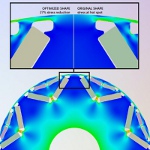 After a long and successful OEM partnership with Ansys, mesh morphing pioneer RBF Morph has two proprietary products featured among the world simulation leader's offerings: Ansys RBF Morph Fluids and Ansys RBF Morph Structures. Thanks to mesh morphing, companies can substantially reduce computational time while performing highly automated design optimization analysis, increasing products' reliability and performance while cutting costs, delivery time, and environmental impact.
After a long and successful OEM partnership with Ansys, mesh morphing pioneer RBF Morph has two proprietary products featured among the world simulation leader's offerings: Ansys RBF Morph Fluids and Ansys RBF Morph Structures. Thanks to mesh morphing, companies can substantially reduce computational time while performing highly automated design optimization analysis, increasing products' reliability and performance while cutting costs, delivery time, and environmental impact.
Read the full article.
Top Tech Tip: Creating drafts with the rib feature in Onshape
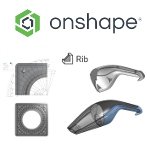 Ribs are used to add stiffness and strength to parts without adding excessive weight or increasing wall thickness -- most commonly in molded parts that require a draft angle so the part can release from the mold. See the basics of how this is done in Onshape, which features the power of cloud computing, real-time collaboration tools, and a built-in PDM system -- all for the same price as CAD.
Ribs are used to add stiffness and strength to parts without adding excessive weight or increasing wall thickness -- most commonly in molded parts that require a draft angle so the part can release from the mold. See the basics of how this is done in Onshape, which features the power of cloud computing, real-time collaboration tools, and a built-in PDM system -- all for the same price as CAD.
Learn more.
How to design a spoon with subdivision modeling: SOLIDWORKS xShape
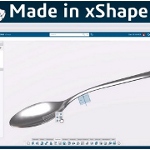 Learn how to design a spoon with SOLIDWORKS xShape, which is found in 3D Sculptor on the 3DEXPERI-ENCE platform. xShape is a next-gen subdivision modeling tool that runs entirely in your browser and takes a freeform approach to creating complex shapes and surfaces. You can design 100% in the cloud or seamlessly integrate your xShape models with your SOLIDWORKS designs. Follow along with this 7-minute tutorial to see what it's all about.
Learn how to design a spoon with SOLIDWORKS xShape, which is found in 3D Sculptor on the 3DEXPERI-ENCE platform. xShape is a next-gen subdivision modeling tool that runs entirely in your browser and takes a freeform approach to creating complex shapes and surfaces. You can design 100% in the cloud or seamlessly integrate your xShape models with your SOLIDWORKS designs. Follow along with this 7-minute tutorial to see what it's all about.
View the video.
What's new in Onshape?
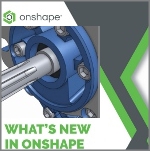 Check out the latest updates to Onshape, the cloud-native product development platform that delivers professional-grade CAD capabilities with next-gen product data management. New features include customizable keyboard shortcuts, better BOM navigation, improved drawing tools, and new Learning Center content. With Onshape, users can innovate quickly while simultaneously or asynchronously collaborating with other stakeholders on any web-connected device.
Check out the latest updates to Onshape, the cloud-native product development platform that delivers professional-grade CAD capabilities with next-gen product data management. New features include customizable keyboard shortcuts, better BOM navigation, improved drawing tools, and new Learning Center content. With Onshape, users can innovate quickly while simultaneously or asynchronously collaborating with other stakeholders on any web-connected device.
View the video.
Open-access learning center for multiphysics modeling
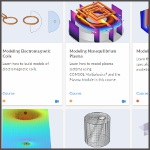 COMSOL, the developer of the COMSOL Multiphysics simulation software, has introduced a new online resource that provides no-cost, open access to modeling and simulation learning material across all areas of physics. Designed with the user in mind, the Learning Center offers a single entry point for users of all skill levels, where courses, articles, and videos present a clear path for learning how to use COMSOL Multiphysics for modeling and simulation.
COMSOL, the developer of the COMSOL Multiphysics simulation software, has introduced a new online resource that provides no-cost, open access to modeling and simulation learning material across all areas of physics. Designed with the user in mind, the Learning Center offers a single entry point for users of all skill levels, where courses, articles, and videos present a clear path for learning how to use COMSOL Multiphysics for modeling and simulation.
Check out the COMSOL Learning Center.
Novel new rotary electrical contact eliminates reliance on rare-earth magnets for large-scale wind turbines

Sandia National Laboratories' Twistact technology has proven beneficial in lowering costs, improving sustainability, and reducing maintenance for next-generation direct-drive wind turbines. [Credit: Photo by Zhang Fengsheng/Unsplash]
Motivated by the need to eliminate expensive rare-earth magnets in utility-scale direct-drive wind turbines, Sandia National Laboratories researchers developed a fundamentally new type of rotary electrical contact. Sandia is now ready to partner with the renewable energy industry to develop the next generation of direct-drive wind turbines.
Sandia's Twistact technology takes a novel approach to transmitting electrical current between a stationary and rotating frame, or between two rotating assemblies having different speeds or rotational direction, making it ideal for applications in wind turbines.
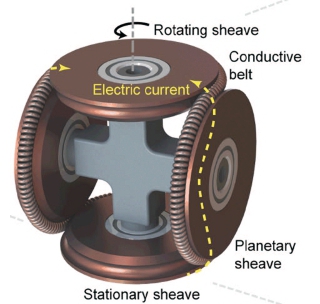
Graphic illustration of the basic principle of the Twistact operation. Sandia National Laboratories is now ready to partner with the renewable energy industry to transfer the technology to develop the next generation of direct-drive wind turbines. [Credit: Graphic courtesy of Sandia National Laboratories]
"Twistact originated by asking ourselves some really challenging questions," said Jeff Koplow, Sandia research scientist and engineer. "We knew it could be game-changing if we could find a way to get around the limited service lifetime of conventional rotary electrical contacts."
"I started thinking that maybe not every conceivable rotary electrical contact architecture has been thought of yet," Koplow said. "We spent a lot of time considering if there was another plausible way."
The resulting innovation, Twistact, uses a pure-rolling-contact device to transmit electrical current along an ultra-low-resistance path. The technology proves beneficial in lowering costs, improving sustainability, and reducing maintenance.
Eliminating reliance on rare-earth metals
Most of the current utility-scale wind turbines are dependent on rare-earth magnets, Koplow said. These materials come at a high initial cost and are vulnerable to supply chain uncertainties.
In 2011, for example, there was a rare-earth materials supply chain crisis that caused the price of neodymium and dysprosium, the two rare-earth elements widely used for such magnets, to skyrocket. This had the potential to block growth of the wind industry. The Sandia team began developing Twistact at the time as a hedge to protect the growing wind industry from future disruptions.
"When you weigh in the fact that rare-earth metals have always been in short supply, that their mining is notorious for its adverse environmental impact, and that competing applications such as electric vehicles are also placing demand on rare-earth metals, the value proposition of Twistact becomes clear," Koplow said.
No maintenance or replacement costs
Additionally, Sandia's Twistact technology addresses two physical degradation processes common to high-maintenance brush or slip ring assemblies -- sliding contact and electrical arcing. These limiting factors reduce the performance of traditional rotary electrical contacts and lead to short operating lifetimes and high maintenance or replacement costs.
Twistact, on the other hand, has been proven through laboratory testing to be capable of operating over the full 30-year service time of a multimegawatt turbine without maintenance or replacement.
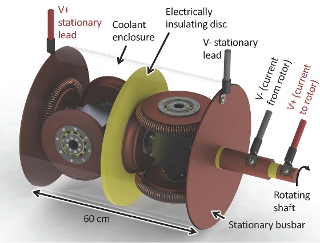
A two-channel Twistact device for a multimegawatt direct-drive wind turbine application, designed at Sandia National Laboratories. [Credit: Graphic courtesy of Sandia National Laboratories]
Other potential applications for the technology include synchronous motors and generators, electrified railways, and radar towers. Twistact could also be used in replacing brush or slip rings in existing applications.
Forward-thinking investment
Koplow credits Sandia's Laboratory Directed Research and Development program for their thinking toward the future in making an investment in Twistact.
"Twistact represents a pretty radically different idea," Koplow said. "That takes courage to get behind and fund."
Sandia is now exploring opportunities to partner with generator manufacturers and others in the renewable energy industry to assist with the transfer of Twistact technology into next-generation direct-drive wind turbines. Further, Sandia is open to partnering on the development of high-RPM Twistact technology for applications such as electric vehicles or doubly fed induction generators.
Last December, Twistact was selected as one of four National Nuclear Security Administration technologies to be presented at the Frontier Venture Summit, a showcase event hosted by FedTech, a venture firm that helps transition technologies from labs to the market. Sandia researchers also presented Retsynth, comprehensive software that aids scientists in synthetic biology analysis, at the showcase.
Read a very detailed presentation on Twistact, "Sandia's Twistact Technology: Decarbonization of the Energy Sector in the 2030 Time Frame," by going to www.osti.gov/servlets/purl/1761109/.
Source: Sandia
Published October 2022
Rate this article
View our terms of use and privacy policy
